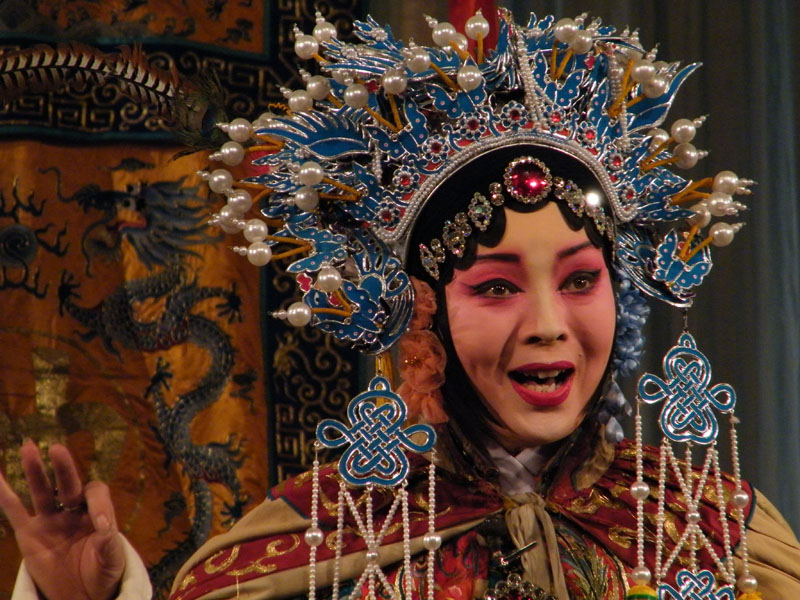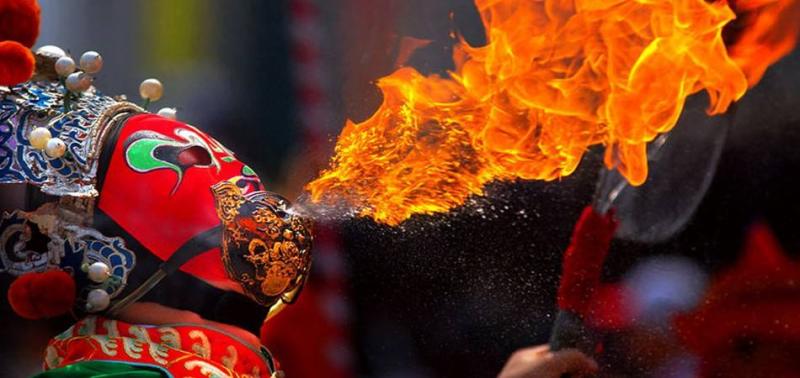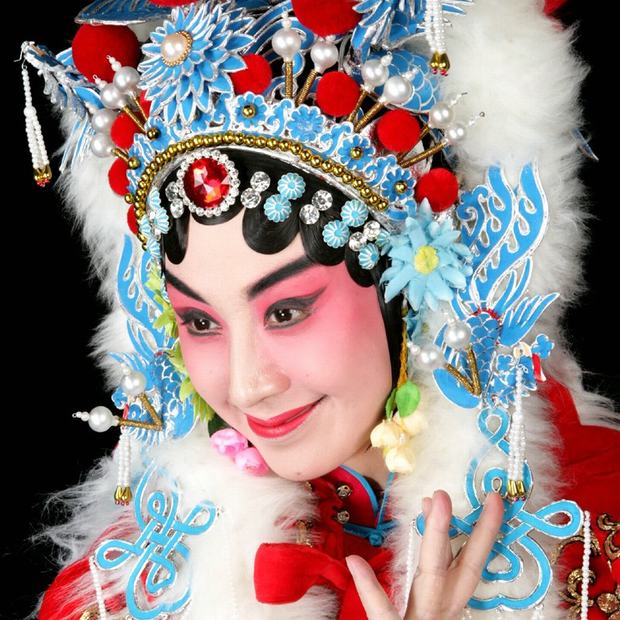Chinese Opera
Chinese opera is mainly composed of three different art forms: folk dance, singing/talking and burlesque. It originated from the God-entertaining songs and dances in the prehistoric society, and has been a comprehensive stage art style with a long history. After the gradual development in continuous Han, Tang, Song and Jin Dynasties, a relatively mature opera art came into being in Yuan Dynasty (12th century). Synthetically being consisted of ancient literature, traditional Chinese dance, music, fine arts, kung fu, acrobatics and performance art, the Chinese opera boasts more than 360 genres, which co-exist in the vast land of the country. Currently the most influential operas in China are Peking Opera, Yue Opera, Huangmei Opera, Ping Opera, Henan Opera and Cantonese Opera. Chinese opera, Greek theater, and Indian Sanskrit opera are well known as the world’s three ancient performing arts.

The features of Chinese opera:
Comprehensiveness, Stylization, and Fictitiousness are the main artistic characteristics of Chinese opera. These characteristics condense the quintessence of Chinese traditional culture's aesthetic thoughts and constitute a unique view of drama, making Chinese opera shine with its unique artistic brilliance on the stage of world opera culture.
■ Comprehensiveness
Chinese opera is a highly comprehensive folk art of Han people. This comprehensiveness is not only manifested in its integration of various art categories (such as song, dance, costumes, acrobatics, etc.), but also in its exquisite performing arts. Various artistic elements are closely integrated with performing arts, and all functions and effects of opera are realized through the performance of actors. Chinese opera is an amalgamation of various art forms depicting the historic stories and traditional Chinese lifestyle, based on a comprehensive performance of speech, song, dance and combat, the four must-have skills for the performers.
■ Stylization
Performance on stage reflects our actual life, which embodies the painstaking efforts of artists throughout the ages. Being passed down from generation to generation, a standardized format of stage performance have been fixed, like the acts of closing doors, pushing windows, mounting horses, boarding boats, going upstairs, etc. In addition to the performance stylization, Chinese opera has a whole set of standards and requirements in terms of script form, role playing, musical accompaniment, singing/talking, makeup and costume. Based on that, outstanding artists can also break through some limitations of the program and create their own personalized style.
■ Simulation
It refers to the performance of actors, actresses and stage backdrop, using a simulated way to reflect the real life. The fictitious nature of Chinese opera is first manifested in the flexibility of handling stage time and space, just like the old saying: "three-to-five steps cross all over the world, six or seven fellows make one-million-man army"; "in the blink of an eye, a few years has passed, at the time of a joss stick burning merely one inch, thousands of years were gone”. This breaks through the limitations of the “classical unities” and “fourth wall” of Western opera. In terms of the specific stage atmosphere scheduling and the actors' simulation of certain life actions, such as wind and rain, boats and horses, threading needles, etc., it is more vivid and imaginative to reflect the fictitious characteristics of opera.

Chinese opera History - Chronicle of Chinese opera:
■ Initial Stage (ancient time before Qin Dynasty 221-207BC)
In the primitive society, the original songs and dances were created to entertain the gods in the community. Some songs/dances were recorded in the books like Book of Documents, Spring and Autumn of Master Lu written in Spring and Autum Period (770-476 BC) and the Warring States Period (475-221BC). Even nowadays, we can still find a clue of primitive songs/dances when watching the masked Nuo dances in the remote areas of China. After Qin Dynasty, from Han to Tang Dynasty, more artistic forms related to performing arts came up. That is the very early stage of Chinese opera.
■ Forming Stage (Tang Dynasty)
In the mid of Tang Dynasty (618-907), Chinese opera gradually came into being. The eighth emperor Xuanzong of Tang Empire excelled at music and lyrics. He ordered to set up an organization called Li Yuan with several hundred male and female musicians in his royal palace. He even played roles in the dramas. So he was regarded as the Founder of Chinese Opera in old days.
■ Development Stage (Song and Jin Dynasty)
Operas began to widespread in the territory of Song (960-1279) and Jin Dynasty (1115-1234). The public gradually accepted the theatrical art form as a type of entertainment in their spare time.
■ Maturity Stage (Yuan Dynasty)
Until reaching Yuan Dynasty (1271-1368), Chinese opera entered into the era of maturity. The vast empire was set up by Mongolians. With its expansion to the South, the art form of Za Opera (Zaju) was also transmitted to all over the country, which was originally centered on Dadu (now Beijing) and popular in North China. As the founder of Zaju in Yuan Dynasty, Guan Hanqing was the greatest and most fruitful playwright in that period.
■ Prosperity Stage (Ming and Qing Dynasty)
In Ming and Qing Dynasty, Chinese operas flourished with hundreds of genres all through the country by integrating local dialect and cultural background. Chuanqi Opera was created from Naxi (South Drama), which had been born in Wenzhou and developed based on Za Opera of Song Dynasty. The most influential dramatist in the era was Tang Xianzu, known as China’s Shakespeare. His masterpiece, the Mudan Ting (The Peony Pavillion) has been translated into English several times. A translation of his complete dramatic works in English was published in China in 2014 and in London in 2018.
■ In modern time
After the downfall of Qing Dynasty, a group of accomplished opera artists are engaged in the improvement of opera art. They have accumulated valuable experience for the later improvement of opera. During the period, Peking Opera became the mainstream genre of drama in this country. Many outstanding opera performers emerged, such as Mei Lanfang, Cheng Yanqiu, Shang Xiaoyun and Xun Huisheng. The Western audience began to know the traditional theatrical art of China during the age.
After the founding of New China, more and more acclaimed dramas were produced in 1950s. Later Chinese opera experienced ups and downs until the end of the Cultural Revolution. With the reform and opening up to outside world, Chinese opera turned over a new leaf and flourished again across the country. A number of ten operas were added into the list of National Intangible Cultural Heritage: Peking Opera (京剧), Shadow Play (皮影戏), Chuan Opera (川剧), Tibetan Opera (藏戏), Hui Opera (徽剧), Yue Opera (越剧), Yu Opera (豫剧), Huangmei Opera (黄梅戏) and Yue Opera (粤剧).

Other information about Chinese opera - makeup
The must-have skills of Chinese opera performers include speech, song, dance and combat. The presentation of body movements on stage are required to be symbolic, implicit and suggestive, rather than realistic. This is unique in the history of world theater.
The facial makeup of Chinese opera is an implicit and innovative way to reflect the identities of roles due to the limitations of the smaller performing stage and the backward technique of stage art in ancient times. Meanwhile, it is also the product of the traditional aesthetics of pursuing the likeness in spirit, which has greatly inspired the creativity of writers and stage artists, and liberated the artistic imagination of audiences, thereby greatly improving the aesthetic value of opera.